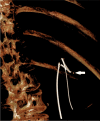Intraoperative cone beam computed tomography for detecting residual stones in percutaneous nephrolithotomy: a feasibility study
- PMID: 33683420
- PMCID: PMC8560674
- DOI: 10.1007/s00240-021-01259-1
Intraoperative cone beam computed tomography for detecting residual stones in percutaneous nephrolithotomy: a feasibility study
Abstract
Cone beam computed tomography (CBCT) provides multiplanar cross-sectional imaging and three-dimensional reconstructions and can be used intraoperatively in a hybrid operating room. In this study, we investigated the feasibility of using a CBCT-scanner for detecting residual stones during percutaneous nephrolithotomy (PCNL). Intraoperative CBCT-scans were made during PCNL procedures from November 2018 until March 2019 in a university hospital. At the point where the urologist would have otherwise ended the procedure, a CBCT-scan was made to image any residual fragments that could not be detected by either nephroscopy or conventional C-arm fluoroscopy. Residual fragments that were visualized on the CBCT-scan were attempted to be extracted additionally. To evaluate the effect of this additional extraction, each CBCT-scan was compared with a regular follow-up CT-scan that was made 4 weeks postoperatively. A total of 19 procedures were analyzed in this study. The mean duration of performing the CBCT-scan, including preparation and interpretation, was 8 min. Additional stone extraction, if applicable, had a mean duration of 11 min. The mean effective dose per CBCT-scan was 7.25 mSv. Additional extraction of residual fragments as imaged on the CBCT-scan occurred in nine procedures (47%). Of the follow-up CT-scans, 63% showed a stone-free status as compared to 47% of the intraoperative CBCT-scans. We conclude that the use of CBCT for the detection of residual stones in PCNL is meaningful, safe, and feasible.
Keywords: Cone beam computed tomography (CBCT); Percutaneous nephrolithotomy (PCNL); Residual fragments; Urolithiasis.
© 2021. The Author(s).
Conflict of interest statement
All the authors certify that they have no affiliations with or involvement in any organization or entity with any financial interest or non-financial interest in the subject matter or materials discussed in this manuscript.
Figures




References
MeSH terms
LinkOut - more resources
Full Text Sources
Other Literature Sources

